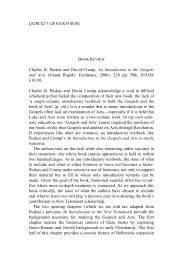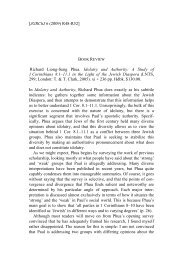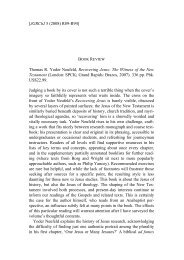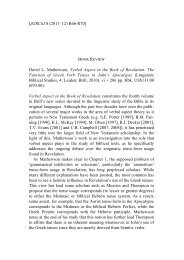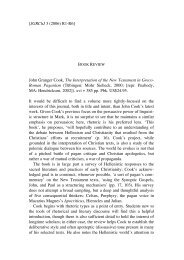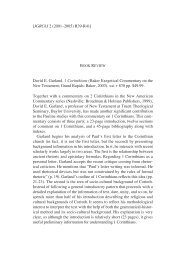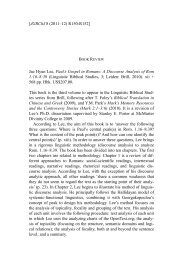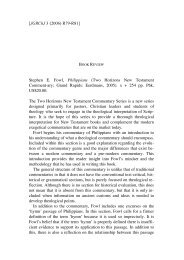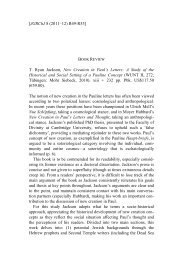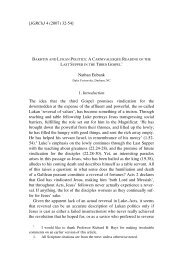John H. Dobson, Learn New Testament Greek Grand Rapids
John H. Dobson, Learn New Testament Greek Grand Rapids
John H. Dobson, Learn New Testament Greek Grand Rapids
You also want an ePaper? Increase the reach of your titles
YUMPU automatically turns print PDFs into web optimized ePapers that Google loves.
[JGRChJ 8 (2011–12) R61-R65]<br />
BOOK REVIEW<br />
<strong>John</strong> H. <strong>Dobson</strong>, <strong>Learn</strong> <strong>New</strong> <strong>Testament</strong> <strong>Greek</strong> (<strong>Grand</strong> <strong>Rapids</strong>: Baker<br />
Academic, 3rd edn, 2005). xiii + 384 pp. Hbk. US$34.99.<br />
There is no doubt that translation is central to the process of learning<br />
and interacting with a new language. Evidently, translation is of primary<br />
importance in <strong>John</strong> <strong>Dobson</strong>’s <strong>Greek</strong> pedagogy, which seeks to be a<br />
resource that provides the groundwork for basic reading skills in the<br />
<strong>Greek</strong> <strong>New</strong> <strong>Testament</strong> and future advanced academic study. While<br />
Baker Academic provides a variety of resources for the study of <strong>New</strong><br />
<strong>Testament</strong> <strong>Greek</strong>, the third edition of <strong>Learn</strong> <strong>New</strong> <strong>Testament</strong> <strong>Greek</strong> provides<br />
a noteworthy addition as an inductively-driven and translationcentred<br />
textbook.<br />
Inductive teaching methods differ from deductive methods (as found<br />
in other common introductory <strong>New</strong> <strong>Testament</strong> <strong>Greek</strong> texts such as<br />
Mounce [Zondervan], or Porter, Reed and O’Donnell [Eerdmans]) by<br />
avoiding the use of grammatical ‘rules’ and forms in favour of intuitive<br />
learning through immersion. It is common for <strong>Greek</strong> textbooks to<br />
provide an explicit course, taking the student gradually through various<br />
grammatical forms—a pedagogical stepladder of sorts. In accordance<br />
with true inductive style, <strong>Dobson</strong>’s stepladder is far from explicit, and<br />
formal designations such as nominative, aorist, subjunctive, and the<br />
like, appear much later than when the form is learned. For example,<br />
while the present tense-form is taught in lessons 3 and 4, it is not until<br />
lesson 14 that tense terminology is explicated. Instead, students are<br />
expected to learn grammatical patterns through immersion in fabricated<br />
examples as well as examples from the <strong>New</strong> <strong>Testament</strong>, aided by the<br />
provision of lexical and grammatical translational equivalents. The<br />
theory behind this inductive approach is founded upon a conviction<br />
that learning a language through immersion (as children do when<br />
learning to speak) provides the best way to absorb, understand and<br />
learn a new language. Interestingly, there is a noticeable lack of the
R62 Journal of Greco-Roman Christianity and Judaism 8<br />
accompanying social scenarios that attend childhood language<br />
acquisition, which makes this method slightly suspect from the outset.<br />
<strong>Dobson</strong>’s grammar lacks complete paradigms or morphology charts<br />
that might allow the student to learn particular verb- or noun-form<br />
inflections. Instead, selected forms are provided (with translation<br />
equivalents) and followed by a series of short formulated sentences to<br />
be translated that include this new form. For example, in lesson 21 the<br />
student is told that e0poi/hsa means ‘I did, I made’, e0poi/hsamen means<br />
‘we did, we made’, e1graya means ‘I wrote, I did write’, and<br />
e0gra/yamen means ‘we wrote’. Eight short translation exercises follow<br />
that contain these four words (English glosses are provided in a righthand<br />
column for comparison). This section is followed by two others<br />
that provide second and third person forms. While it takes a degree of<br />
intuition to determine the relationship of these inflections, the benefit<br />
of this approach is immediate practice in translating the forms in<br />
context. At this point <strong>Greek</strong> grammar is not an abstract concept but<br />
contextualized with verbal forms interacting with lexico-grammatical<br />
features.<br />
<strong>Dobson</strong>’s approach is creatively formulated and consistent with his<br />
aims and convictions, i.e. an emphasis on translation and intuition. An<br />
inductive approach is meant to provide positive reinforcement as the<br />
learner begins to read excerpts from the <strong>Greek</strong> <strong>New</strong> <strong>Testament</strong> within a<br />
very short span of time after the commencement of study. Within the<br />
first two (short) lessons, the student has learned the <strong>Greek</strong> alphabet,<br />
pronunciation and enough vocabulary to read Jn 1.1-2. From that point<br />
on the student begins to learn at a slow but steady pace (there are 52<br />
lessons in total) learning fundamental vocabulary and grammar so that<br />
by lesson 8 the student is asked to translate their first lengthy passage<br />
(12 lines). Segments for translation contain increasingly longer and<br />
more complex portions of the <strong>New</strong> <strong>Testament</strong> to be translated. By lesson<br />
20 (the end of section 1), the student has been introduced to number<br />
and gender, present and imperfect tense-forms, four noun cases, the<br />
active voice, indicative and subjunctive moods, present infinitives,<br />
inflections of the article, prepositions, several conjunctions, relative<br />
and demonstrative pronouns and present participles. By lesson 35 (the<br />
end of section 2), the student has been introduced to the aorist, future,<br />
and (plu)perfect tense-forms, aorist infinitives, aorist participles,<br />
adjectives, middle and passive voice, and mi verbs, as well as the<br />
technical terms associated with these forms. The final chapters do not
Review: DOBSON <strong>Learn</strong> <strong>New</strong> <strong>Testament</strong> <strong>Greek</strong> R63<br />
introduce much new information as most of the major grammatical<br />
forms have been introduced. <strong>New</strong> vocabulary items continue to appear<br />
and, most importantly, <strong>Dobson</strong> begins to be more explicit with his<br />
grammatical description in greater detail—including discussions of<br />
<strong>Greek</strong> cases and the role of the preposition. <strong>Dobson</strong> finishes his<br />
textbook off with exegetical aids including an introduction to word<br />
families, what he perceives to be the influence of Hebrew on <strong>New</strong><br />
<strong>Testament</strong> <strong>Greek</strong>, an introduction to textual criticism, notes on the<br />
relationship between culture and translation and an introduction to<br />
useful resources for <strong>Greek</strong> students. These latter chapters are a unique<br />
and useful feature of this grammar.<br />
Used properly, this text has the ability to be a positive resource.<br />
Despite its lack of explicitness, the student is able to learn forms well<br />
and in context through numerous translation exercises immediately<br />
after a particular form is learned. The third major section (lessons 35-<br />
52) provides necessary sophistication to the forms already learned,<br />
which take the student from basic knowledge to the foundation for<br />
critical exegetical skills.<br />
It would be amiss to neglect an extended critique of this text as it<br />
contains, in my opinion, several considerable shortcomings. At the<br />
outset, the logic behind some of the structuring of the textbook is curious.<br />
For example, in lesson 19, the student is formally introduced to<br />
the article and its inflections. This seems to be illogical placement as<br />
the noun cases were explained several lessons earlier. It makes better<br />
sense to learn the article along with the noun cases insofar as they can<br />
be mutually helpful in parsing and translation. Another concerning<br />
feature is the goals and claims of this text, which seem to be slightly<br />
confused or contradictory. On p. i, the claim is made that the text ‘takes<br />
beginners from the first stage of learning to read <strong>Greek</strong> syllables and<br />
words to a stage where they can tackle the Gospels and work at a University<br />
level’. On the following page, however, it explicitly reduces its<br />
goals to the ability to read and translate well and with confidence. It is<br />
my opinion that these are not harmonious and that the text only fulfills<br />
the second goal.<br />
To learn a language is to learn it in its own right, as a system of symbols<br />
that allow for a comprehensive communication of reality. It seems<br />
contradictory to that purpose to learn a language in terms of another. In<br />
<strong>Dobson</strong>’s text, <strong>Greek</strong> is taught primarily by how it corresponds to English.<br />
Thus, grammatical features are taught according to how they
R64 Journal of Greco-Roman Christianity and Judaism 8<br />
might be rendered in English, rather than how that form is used to<br />
construe reality within the <strong>Greek</strong> language or in relation to other forms.<br />
For example, in lesson 5 we learn that the ending omen means ‘we’, ete<br />
means ‘you’, and ousin/ousi means ‘they’. Three issues arise. First, in<br />
this description there has been a blending of the connecting vowel and<br />
the personal verb ending. Secondly, there is no discussion of how or<br />
why these endings mean what they do (in other words, how this fits<br />
into the <strong>Greek</strong> person system). Thirdly, there seems to be confusion<br />
between translational equivalence and meaning. It is appropriate to<br />
translate verbs ending in omen with ‘we’ (though not always, if, for example,<br />
the subject of the verb appears in the clause). However, strictly<br />
speaking, it is not what that ending ‘means’. <strong>Dobson</strong> further suggests<br />
that when struggling to make sense of difficult words it can be helpful<br />
to look at English cognates; thus fw~j may remind us of the word<br />
‘phosphorus’ or ‘photograph’. These sorts of patterns are consistent<br />
throughout. I suggest that this strategy will leave the student understanding<br />
<strong>Greek</strong> only in terms of English equivalents rather than learning<br />
<strong>Greek</strong> as its own language system.<br />
Another important problem is an apparent ignorance of or disregard<br />
for several developments in <strong>Greek</strong> language study over the past several<br />
decades, which can significantly inhibit the student’s grasp of the<br />
<strong>Greek</strong> of the <strong>New</strong> <strong>Testament</strong> and its subsequent application to reading,<br />
exegesis and more advanced study. First, the verbal system is taught as<br />
fundamentally time-based and using Aktionsart categories (though<br />
<strong>Dobson</strong> does mention that context is an important feature that aids in<br />
the determination of time) and makes no mention of verbal aspect<br />
theory in any of its forms. For example, the student is taught that the e-<br />
augment indicates past time, the present and imperfect tenses represent<br />
continuous or repeated action and the aorist tense represents completed<br />
or single action. This is an appropriate decision to make if <strong>Dobson</strong> is<br />
convinced of this position (even if it is not a responsible decision).<br />
However it is amiss to omit any recognition of the existence of verbal<br />
aspect theory. The first edition of this book was published in 1988,<br />
prior to any sustained and detailed discussion of verbal aspect theory.<br />
However, by the second edition (1993) and certainly by this third edition<br />
(2005) verbal aspect theory (in all of its manifestations) requires<br />
that a beginning grammar at least interact with it. This is a serious<br />
shortcoming.
Review: DOBSON <strong>Learn</strong> <strong>New</strong> <strong>Testament</strong> <strong>Greek</strong> R65<br />
Secondly, <strong>Dobson</strong> pushes very hard to argue for an extreme Semitic<br />
influence on the <strong>Greek</strong> language. Early on in the text he writes, ‘I have<br />
also discovered that often a word or passage in the <strong>New</strong> <strong>Testament</strong> that<br />
is perplexing becomes clear when it is translated back into Hebrew’<br />
(p. ix). As the textbook unfolds, <strong>Dobson</strong> makes frequent reference to<br />
Hebraic literary patterns present in <strong>New</strong> <strong>Testament</strong> texts such as chiasms.<br />
In lesson 48, <strong>Dobson</strong> engages in an extended discussion of the<br />
Hebrew and Aramaic influence on <strong>New</strong> <strong>Testament</strong> writers. His argumentation<br />
is largely based on anecdotal evidence from his experiences<br />
in foreign/multilingual countries and from teaching Mark’s Gospel,<br />
which appears to <strong>Dobson</strong> to be written in <strong>Greek</strong> but with Hebrew<br />
thoughts behind it. To some degree this position is quite antiquated and<br />
while there may be, in some sectors, those scholars who wish to maintain<br />
the theory of an extensive Semitic influence, there is a strong<br />
contingent who wish to minimize its influence. At the very least (as<br />
with his treatment of the verb system), <strong>Dobson</strong> should acknowledge<br />
competing positions. One expects that a textbook, as it experiences<br />
progressive editions, should keep up with developments in its field.<br />
This clearly has not been the case with this work.<br />
<strong>Learn</strong> <strong>New</strong> <strong>Testament</strong> <strong>Greek</strong> provides a creative, inductive approach<br />
to learning <strong>Greek</strong> that emphasizes immersion in the text and contextdriven<br />
intuition. However, the unsophisticated treatments of Semitic<br />
influence and the <strong>Greek</strong> verbal system, accompanied by an overemphasis<br />
on translation equivalence, suggests that this a text that does not<br />
measure up to the level of <strong>Greek</strong> language research developed over the<br />
course of the past two decades. As a result I am inclined not to recommend<br />
this text as a resource for first-year Geek teachers or students.<br />
Gregory P. Fewster<br />
McMaster Divinity College



